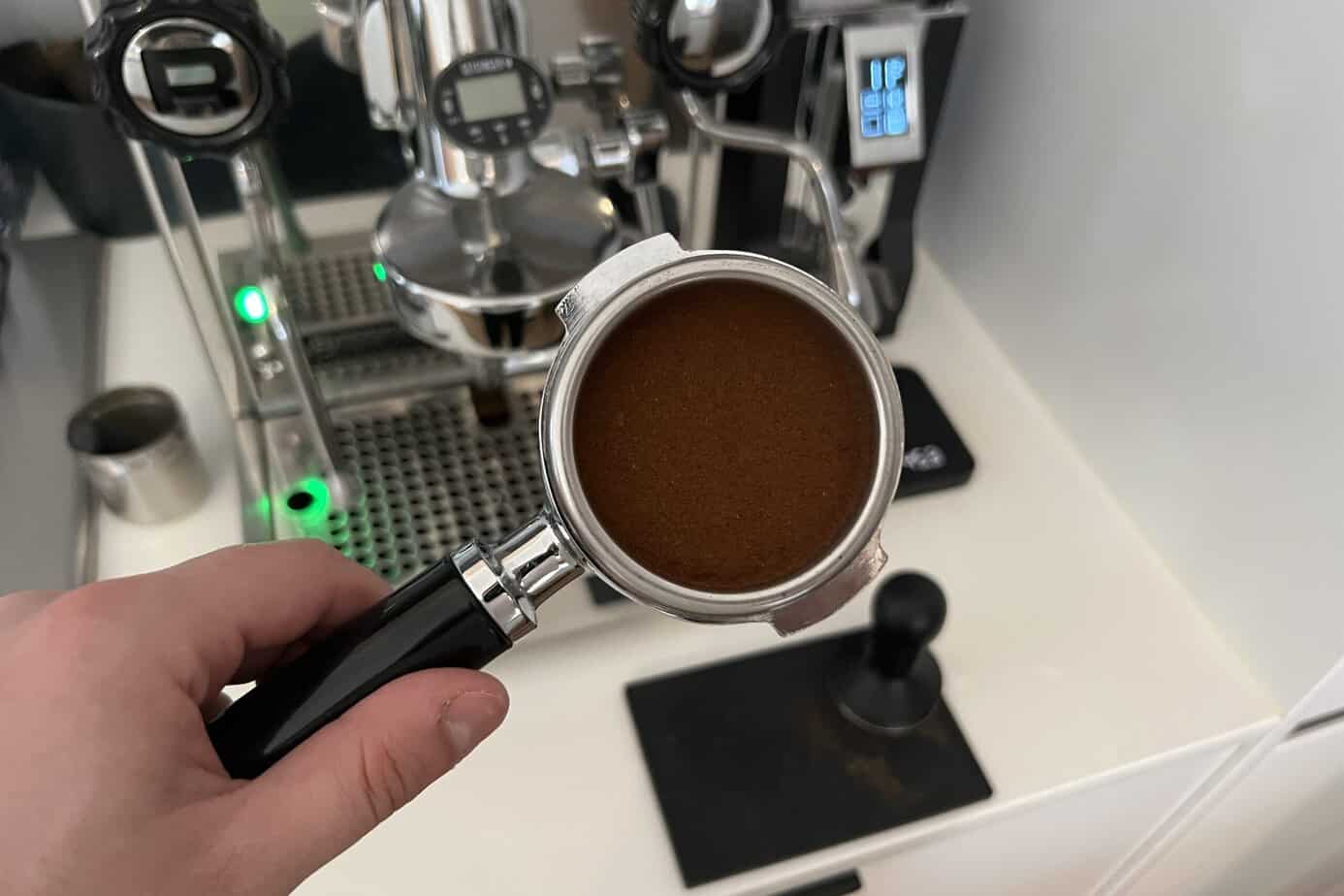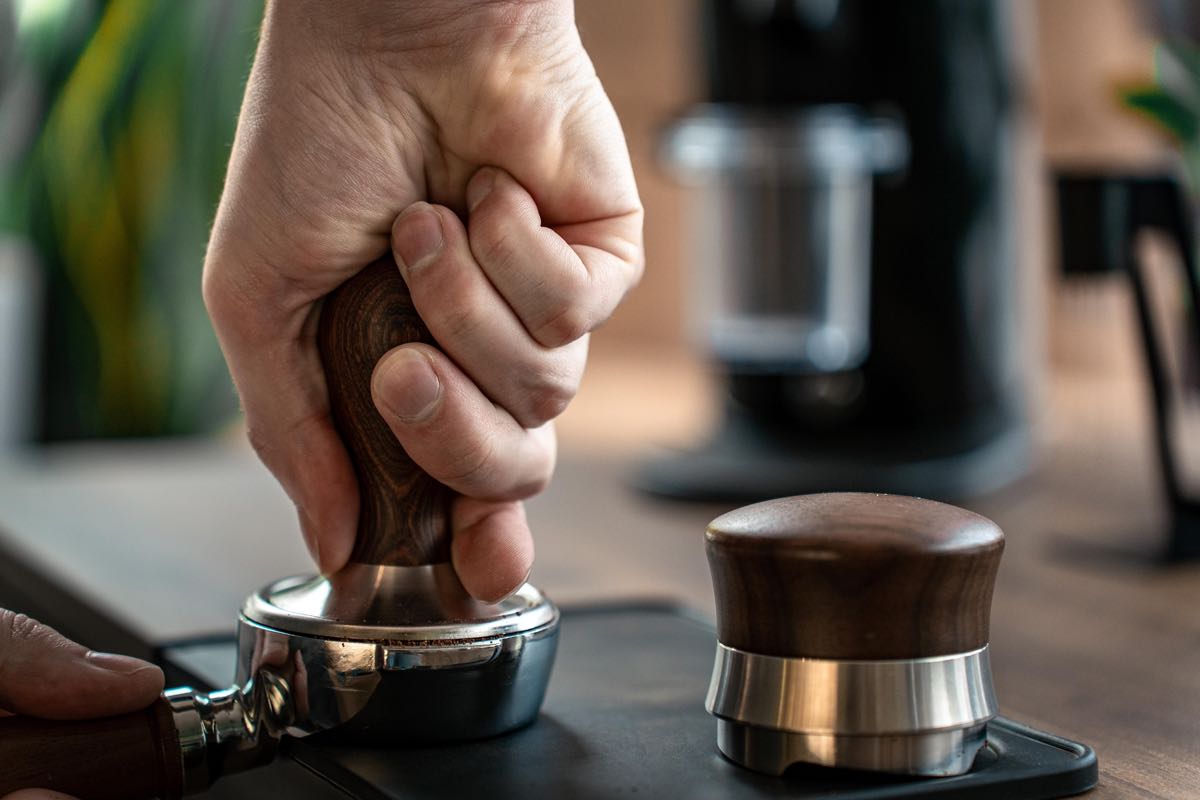As someone who’s passionate about making espresso at home, one of the most common questions I get is about tamping: "How hard should you tamp when making espresso at home?" This seemingly small step can have a big impact on the quality of the espresso you brew, and knowing the right pressure to apply can be the difference between a shot that’s rich, full-bodied, and delicious or one that’s under-extracted and bitter. So let’s dive into this crucial aspect of espresso preparation, which will help elevate your coffee game. Learn everything about this innovative coffee machine in our DeLonghi Eletta Explore Espresso Machine with Cold Brew review

Understanding the Basics of Tamping for Espresso
Before getting into the specifics of how hard you should tamp, let’s quickly review what tamping actually is. Tamping refers to the process of compressing the ground coffee inside the portafilter to create an even, firm coffee puck. This step is critical because an uneven tamp can lead to channeling, where water passes through the coffee unevenly, resulting in an uneven extraction. This not only affects the taste but also the consistency of your espresso shots. Dive into the features and performance in our DeLonghi Dinamica Automatic Coffee & Espresso Machine review
Tamping creates a uniform surface that allows the water to flow through the coffee grounds evenly. Without tamping, or if tamped incorrectly, you risk producing weak, watery espresso that lacks flavor and depth. Explore the versatility of this model in our DeLonghi Magnifica Evo Espresso Machine with Frother review
The Importance of Proper Tamping Pressure
The next logical question is: how hard should you tamp when making espresso at home? It’s essential to understand that tamping pressure isn’t just about applying force; it’s about consistency and ensuring that the puck is evenly compressed. The right tamp ensures that water passes through the coffee grounds evenly, extracting all the flavors you want. Find out why this model stands out in our DeLonghi Magnifica S review
In general, you should aim for around 30 pounds (13.6 kg) of pressure when tamping. This pressure is often described as "firm but not excessive." However, the key is consistency rather than focusing on precise weight. If you’re not sure about the exact pressure, simply applying a solid, consistent force with the tamper will give you good results.
Why 30 Pounds of Pressure is Recommended for Tamping Espresso
The recommendation to tamp with 30 pounds of pressure comes from years of barista experience and espresso machine testing. Why 30 pounds? It’s enough pressure to ensure that the coffee grounds are evenly compressed without overdoing it. Too much pressure can lead to an overly compact puck, which can block water flow and result in an over-extracted, bitter shot. On the other hand, tamping too lightly can cause an under-extracted shot, leading to sour and weak flavors. Discover the benefits and features of this machine in our DeLonghi Magnifica Evo review
When you tamp with the right amount of pressure, you’re helping the water flow evenly through the coffee, leading to a well-balanced extraction. Think of it as applying the right amount of pressure to form a solid foundation for your espresso shot.
How Hard Should You Tamp When Making Espresso at Home: Common Mistakes to Avoid
As you get the hang of tamping, there are a few common mistakes that I’ve made (and learned from) that you should try to avoid. Here are a few things to keep in mind:
1. Not Applying Enough Pressure
If you don’t tamp firmly enough, the coffee grounds won’t be compacted enough to create a uniform puck. As a result, water will flow unevenly through the grounds, leading to an under-extracted espresso. While it’s easy to get excited about your espresso-making journey, you need to make sure that the tamp is firm enough to compress the grounds but not excessive.
2. Over-Tamping
On the flip side, tamping too hard can lead to a hard, overly compressed coffee puck that restricts water flow, causing over-extraction and bitterness. It’s essential to remember that espresso requires an even, balanced pressure. Over-tamping, although tempting, isn’t necessary and can result in a disappointing shot.
3. Inconsistent Tamping Pressure
Another common mistake I’ve made in my espresso-making journey is tamping inconsistently. Sometimes, I would apply pressure unevenly, which led to uneven extraction. Consistency is key when tamping. This is why I prefer using a tamper with a flat base that helps me apply even pressure.
How to Measure Tamping Pressure at Home
While it’s not necessary to measure your tamping pressure every time, there are ways to get a better idea of how hard you’re tamping. Some home baristas use a scale that measures tamping force, and there are also tampers available with built-in pressure sensors. But for most of us, a good way to gauge tamping pressure is by focusing on consistency and feeling. Aim for a firm but controlled push downward with the tamper. It should feel like you’re applying steady pressure without straining.
Factors That Affect Tamping Pressure
Several factors affect how hard you should tamp when making espresso at home. These factors influence the flow of water and the extraction process, so it's good to consider them:
1. The Freshness of Your Coffee Beans
The freshness of your beans can impact how you tamp. Freshly roasted beans often have a greater tendency to resist compression, so tamping slightly harder may be necessary to create an even puck. On the other hand, older beans tend to compress more easily, so tamping with a lighter hand can yield better results.
2. Grind Size
The grind size of your coffee also plays a role in tamping. A finer grind will typically require more tamping pressure because it forms a denser puck, while coarser grinds may not need as much tamping force. If your grind is too fine, you may also experience clumping, which can make tamping difficult and inconsistent. Be sure to adjust your grind size accordingly for optimal tamping pressure.
3. Espresso Machine and Portafilter Size
Different espresso machines and portafilters can affect how much pressure you need to apply. Some espresso machines exert higher pressure during extraction, so a firm but balanced tamp is ideal. For larger portafilters, you might need slightly more pressure to ensure a consistent puck. Similarly, smaller portafilters might require a gentler tamp.
How Hard Should You Tamp When Making Espresso at Home: My Personal Approach
I used to obsess over tamping pressure when I first started brewing espresso at home. But over time, I realized that as long as you’re consistent, you can find a tamping pressure that works for you. For me, I focus on a few key principles:
- Evenness: I always ensure the grounds are spread evenly before tamping, so I don’t have to worry about applying too much force in one area.
- Moderate Pressure: I apply a steady, moderate amount of pressure—around 30 pounds—just like how a professional barista would.
- Consistency: Every time I tamp, I aim for the same level of pressure, so I get consistent shots every time. A tamper with a flat base helps me with this.
I also like to keep my tamping routine simple and repeatable. After all, brewing espresso is all about creating a ritual that works for you.

Conclusion: How Hard Should You Tamp When Making Espresso at Home?
So, how hard should you tamp when making espresso at home? The key takeaway is that tamping should be firm, consistent, and controlled. Aim for about 30 pounds of pressure, but focus more on consistency than achieving an exact weight. With practice, you’ll develop a feel for it and be able to fine-tune your tamping pressure according to your grind size, beans, and equipment.
Tamping might seem like a small step in the overall espresso-making process, but its importance cannot be overstated. When done correctly, it leads to even extraction, better flavor, and a much more enjoyable espresso experience. So, the next time you pull a shot, remember to tamp with intention and care—you might just be surprised by the results!
10 Frequently Asked Questions About Tamping When Making Espresso at Home
1. What is tamping in espresso preparation?
Tamping is the process of pressing down the ground coffee in the portafilter to create a uniform and compressed puck. This ensures an even extraction of flavors when water is forced through the coffee grounds.
2. How hard should I tamp when making espresso at home?
A common recommendation is to apply around 30 pounds (13.6 kg) of pressure when tamping. However, the most important factor is consistency, so focus on applying steady, moderate pressure every time.
3. Why is tamping important for making espresso?
Tamping ensures that the coffee grounds are evenly compressed, creating uniform resistance to the water flow. This prevents uneven extraction, which can result in a poor tasting espresso shot.
4. Can I tamp too hard?
Yes, tamping too hard can create an overly compact puck, which can obstruct water flow, leading to over-extraction. Over-extracted espresso tends to taste bitter and unpleasant. It’s important to tamp with firm but controlled pressure.
5. What happens if I don’t tamp enough?
If you don’t tamp hard enough, the coffee grounds won’t be compressed properly. This can lead to uneven extraction, with some parts of the puck being under-extracted (sour) and others over-extracted (bitter).
6. Is there a specific tamping technique I should follow?
Yes, try to tamp evenly and with a flat tamper to ensure that the coffee surface is level. Hold the tamper straight, applying pressure evenly, and avoid tilting it. This will create a uniform puck and ensure even water flow.
7. Can I measure tamping pressure?
While it’s not necessary to measure tamping pressure every time, some baristas use a scale or a tamper with a built-in pressure sensor to gauge the force. However, many home baristas find that focusing on consistency and feel is sufficient for great espresso.
8. Do I need to tamp differently for different coffee beans?
Yes, the freshness of your coffee beans can affect tamping pressure. Fresh beans tend to resist compression more, so you may need to apply slightly more pressure. Older beans, on the other hand, may need less pressure as they compress more easily.
9. How does grind size affect tamping?
Finer grinds typically require more tamping pressure because they form a denser puck. Coarser grinds may not need as much pressure. If your grind is too fine, clumping can occur, making tamping uneven and inconsistent.
10. Can the type of espresso machine affect tamping pressure?
Yes, different espresso machines apply different levels of pressure during extraction. If your machine uses higher pressure, you may want to tamp with moderate force, ensuring the puck isn’t too compact. Similarly, adjust based on the size of your portafilter to get the best results.
